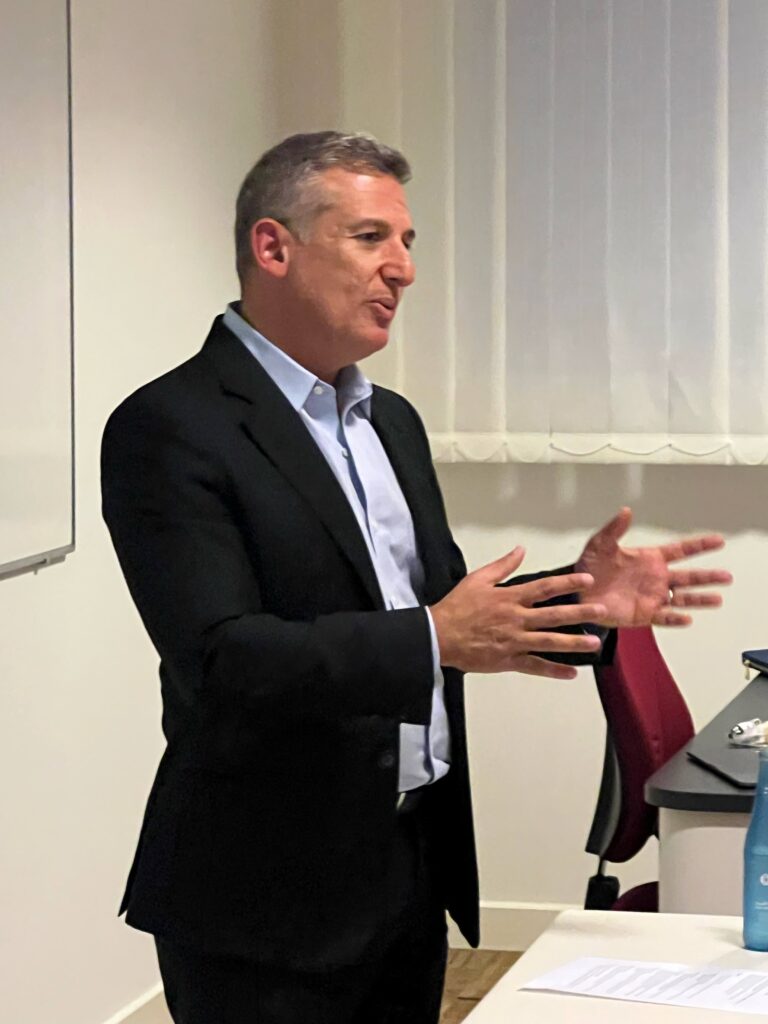ABU DHABI – The CEO of one of the largest media companies in the Middle East encouraged communication students to embrace the future and be the best they can be.
“Don’t be afraid of failure,” said Mazen Nahawi, founder and group CEO of CARMA, a media analysis and intelligence business. “Failure is a constant companion in a journey to success.”
Nahawi met with ZU master’s students on Tuesday evening on the Zayed University Abu Dhabi campus. The meeting was organized by Kyungsun “Karen” Lee, an assistant professor in the College of Communication and Media Sciences, and both current cohorts of master’s students in the college attended the event. The topics Nahawi addressed included how to measure the effectiveness of communication, how to use artificial intelligence tools, and how to be successful as a professional.
Nahawi was born in 1974 in Sharjah and earned his high school degree in Choueifat. He graduated from Northeastern University in the United States in 1996 with a degree in journalism and worked as a reporter for Al Khaleej before switching to corporate communications. Some of his startups include a media intelligence company Media Watch Middle East and a social media marketing business SOCIALEYEZ, which are now a part of CARMA. Nahawi talks of childhood trips to Al Dhaid and is rooting for Sharjah Football Club.
Nahawi’s group of companies analyses media coverage of its clients and gathers opinion data from stakeholder groups. Early in the conversation with ZU students, Nahawi was asked about ways to evaluate whether communication goals are being achieved. This question set off a discussion about measurement and analytics in PR.
Nahawi said that the work of PR professionals is always based on research.
“PR is extremely powerful when it does its homework and when it listens more than it talks,” he said.
Nahawi explained how to identify stakeholder groups and how to tailor messages to serve those groups. He stressed that while conducting surveys is considered to be the job of the marketing departments, PR professionals themselves should survey their stakeholder groups. A good approach could be devoting each month to surveying one stakeholder group. Among other methods of getting feedback from the target audiences, Nahawi named focus groups with stakeholders, clinics where stakeholders can try out a product or service, and in-depth interviews with powerful decision-makers.
During the discussion, Nahawi built on students’ questions, came up with a friendly running joke about Operation Falafel, where the snacks for the event came from, and switched to Arabic to duplicate the names of metrics such as advertising value equivalent.
Nahawi expressed his concerns about the usefulness of some of the metrics. For example, rather than looking at the number of views, he encouraged to look for the number of clicks, “likes,” comments and filled-in forms as well as the number of people who attended an event.
When the conversation led to the perceived decline of legacy media, Nahawi said print media is still used by decision-makers for signals about news events that are deemed important. At one point, he added that he’d prefer to address social media simply as the media because social media now is an irreplaceable part of the media landscape.
At one point student showed the audience a message she liked as an example of effective communication. Soon after, a faculty member asked whether social media is encouraging communicators to shape their messages as bullet points. Nahawi showcased why the student’s example was effective. He advised making sure that messages are confident, clear, and focused on the point: What value does the speaker’s organization deliver to their audience?
Another question from the audience was devoted to the use of AI.
“Keep it balanced,” Nahawi said. “Use it when it helps you, but don’t let it take away from you.”
Nahawi said that AI accelerates basic tasks related to writing news releases, conducting research, and creating content. He reminded that AI follows inputs from a human, and those inputs should be guided by a strategy based on a human relationship with the audience the PR professional serves.
In the workplace with easily accessible AI tools, Nahawi said authenticity in communication is becoming as important as ever. Examples of authentic communication include real stories about real people who are not afraid to show their imperfections. Nahawi said the audiences expect imperfections and are suspicious of overly polished messages.
One of the last questions asked for advice about how to keep growing professionally.
“Be the best you can be,” Nahawi said.
He offered two strategies to follow. One strategy is personal, which includes continuing to learn. For example, traveling the world to meet people who are very different from oneself.
“Go to a PR conference in Europe,” Nahawi said. “Watch a Chinese movie. One-fifth of the world’s population is from there.”
He also advised volunteering time to promote a cause that is important to the communications professional at a personal level. One student said that she practices Pilates. Nahawi quickly brainstormed an idea for a video. He practices Pilates, too.
On a professional level, Nahawi advised talking to professionals outside the PR department and not to be afraid to stop by the CEO’s office because good CEOs are open-minded and want to hear from their teammates.
It was getting late, and Nahawi still had a trip back to Dubai ahead of him.
“Embrace the future!” he said.
